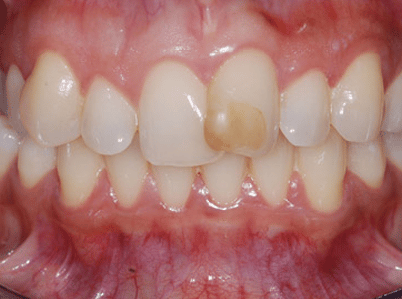Dental Bonding
Dental bonding is a painless way to fix a chipped tooth, hide a discoloured tooth and/or treat tooth decay. Bonding involves shaping and adhering (or “bonding”) composite resin – a form of extremely hard plastic – to a tooth. In cases of a chip, the resin recompletes the shape of the tooth. In cases of fracture or discolouration, it masks the imperfection.
In cases of fracture or discolouration, it masks the imperfection. And in cases of decay, bonding restores the tooth after the decay has been removed. Dental bonding is non-invasive, economical and can typically be performed in one visit without the need for local anesthetic. No recovery time is required following treatment, and multiple teeth can be bonded at the same visit. However, the more teeth bonded at one time, the longer the appointment will be. This should be considered when scheduling the appointment.
The tooth bonding procedure
First, the affected tooth’s surface is prepared to receive the composite resin. A resin colour is then selected to match the colour of your natural teeth. The resin is then layered onto the tooth and bonded in place. Once the bond is secure, we will shape and polish the resin to make it look and feel like a smooth, natural tooth. No one will know the difference and you will feel great about your newly-restored smile. The following video demonstrates the bonding process, how it works and why we often recommend it to
patients.
The advantage of bonding
Bonding can positively impact your smile by hiding unsightly discolouration, restoring chipped teeth to their original shape and filling small gaps between neighbouring teeth. It can make you feel more comfortable smiling with your mouth wide open, improve your appearance in pictures and give you more confidence in social situations.
Learn more about how dental treatments like dental bonding and veneers can be used to improve the look of healthy teeth.


The disadvantage of bonding
The advantage of bonding
Bonding can positively impact your smile by hiding unsightly discolouration, restoring chipped teeth to their original shape and filling small gaps between neighbouring teeth. It can make you feel more comfortable smiling with your mouth wide open, improve your appearance in pictures and give you more confidence in social situations.
Learn more about how dental treatments like dental bonding and veneers can be used to improve the look of healthy teeth.
Swipe to the left.
The disadvantage of bonding
all under one roof
Bonding Q&A
The cost of dental bonding is difficult to determine without an assessment because factors like size, shape, location, number of teeth involved, etc. will impact the overall cost of treatment. After your assessment, your dentist can send an estimate to your insurer to determine whether the proposed treatment is covered under your dental plan and to what extent.
Bonding and veneers are similar in that they are both used to improve the aesthetics of your smile by addressing cosmetic issues associated with your teeth. The main difference relates to the material used in each procedure. In the case of bonding, a resin-based material is applied to the tooth and customized directly to optimize the aesthetics and function of your teeth. A porcelain veneer is a ceramic based material that typically covers the entire tooth. The veneers are made by a dental laboratory and your dentist will cement them in place. Each process has different benefits and your dentist may recommend one or the other based on the nature of the cosmetic issue being addressed as well as various other factors.
Bonding might not always be an appropriate alternative to correct a cosmetic concern. For example, when the spaces between the teeth are too large, when there is significant crowding, when a tooth is severely rotated etc. bonding might not offer an effective cosmetic solution. The appropriateness of bonding is best determined after your dentist has had an opportunity to examine your teeth and understand the cosmetic concern being addressed.
Many factors determine the longevity of dental bonding. Unlike porcelain or other ceramic materials, the resin used in bonding can discolour over time. And, depending on the size, shape and location of the bonding, the forces applied to the resin can diminish the bond’s strength over time. Good homecare and avoiding things that can stain teeth (e.g., cigarettes, red wine, coffee etc.) will increase the life span of the bonding.
If a bonding needs to be revisited, it does not always need to be redone. It may only require a polish or a reshaping.
The routine is similar for people with and without bonding: floss and brush your teeth at least twice a day and visit your dentist regularly. If you have had bonding done, you should avoid biting your nails or chewing on hard things like pens or pen caps. You should also avoid things that can stain your teeth (e.g., blueberries, cherries, cigars etc.) and not skip your regular dental visit. A lot can happen to an older bond over time so they will need to be checked periodically.
Not at all, especially if it is being performed to address a cosmetic concern.






New to the area?
We’re ready to care of your smile! If you’re new to the Yonge and Eglinton area, contact us to make an appointment for any of our services.

